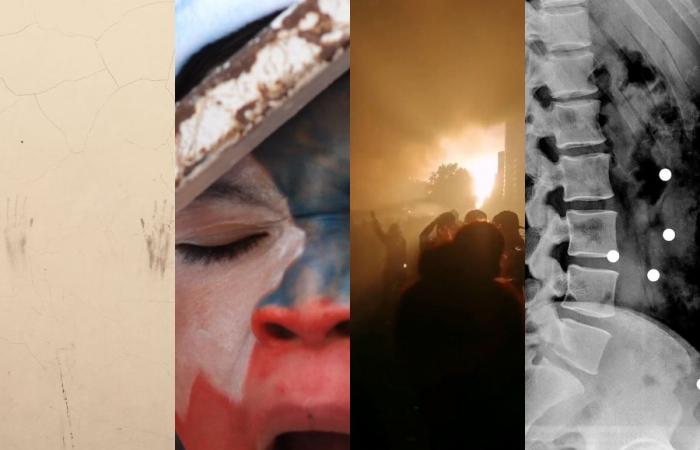This week it opens in theaters He who dances, passes, a documentary about the social outbreak of 2019, built from the records that the protesters themselves were capturing during those days. In a column for CIPER, the director, co-writer and co-producer of the film comments on what clues appear in that spontaneous story when reviewed today: «Those records hid a layer of something that has always been difficult for us to define: what is Chilean. Those amazing ways of using language appeared when we are overcome by anger, joy, class friction, absurdity and unexpected humor in the midst of tragedy. That new look took me to unexpected narrative and aesthetic places.»
dDuring the first weeks of the social outbreak that began on October 18, 2019, I impulsively collected materials that had been posted and reposted on the internet. In those days and weeks, social media was full of images floating between accounts, and the drives It didn’t take long for them to collapse. It was difficult to process everything that was happening on the streets, and so I downloaded everything I could, without order or intention. They were spontaneous records, in which the different forms of protest appeared in many cities in the country and the blatant police violence against some protesters. A lot of them weren’t showing up on television, and they didn’t even go viral.
Over time I had more awareness and insight into what I had gathered. I understood that those popular images had even more complexity than what someone could have done with the explosion from professional cinema. In these low-resolution vertical records, the marks of a decisive moment were leaving. They were cell phone shots, and there was something in the chosen framing, the movement, the silence or the off-screen voice that spoke of a collective energy that had managed to give body to something that was throwing us into the unknown.
We trace some of these images back to a film collective that quickly disintegrated. Later, the defeat in the face of the possibility of a new Constitution left us paralyzed. With the body in one part and the head in another, we felt in emptiness; while that 2019 collection rested in the folder on a hard drive. Some time later I found a compass when I saw Cofralandes, by Raúl Ruiz (2002), a four-part film that, in the words of its director, was like a school book in which poetry, stories, images, recipes and mythology were mixed. An omnivorous work, which gave a glimpse of a dreamlike, absurd, dispersed, hybrid, cultured and popular Chile that lit the spark that prompted me to think again about those archived records.
I reviewed those images, and discovered that all that material that contained a high degree of reality needed to be rediscovered from another place. But you had to take a risk and take the opposite direction: leave the clarity and see with blurred eyes, set up sequences thinking about giving space to contradictory emotions, and reveal the delirious and ghostly tone that those records contained. Then the dream appeared, the political dream, the physiological dream, #ChileDespertó; and then I found the first strand of a possible fictional character that could give substance to that feeling of being between sleep and wakefulness that the failed process had left us. A ghost looking for a body to incarnate. Those records also hid a layer of something that has always been difficult for us to define: what is Chilean. Those amazing ways of using language appeared when we are overcome by anger, joy, class friction, absurdity and unexpected humor in the midst of tragedy. That new look took me to unexpected narrative and aesthetic places. There was no reason to follow a chronological or didactic thread of the process, I concluded. There was nothing to explain. The cinema does not have the need to reconstruct a historical episode, but, rather, to reimagine it.
***
Thus, those first lonely strokes From a project still in formation, they soon became collective, until they became a seventy-minute documentary. In its first cut, He who dances passes It was selected as a work in development in the “Austral Encounters” of the Valdivia Film Festival. By then, María Paz González, producer and key co-writer of the film, had already joined, with whom we sought to give forcefulness to the narrative arc of our characters, real and imaginary; think about your possibilities, look for the subtleties in the point of view that sought to look with complexity and self-criticism at those who were on our path, but also at those who were in front; to suffer again with those images of police violence, to be moved by the ghostly voices of those who wanted to leave a mark in the midst of chaos; to believe and laugh again, to decisively discover that in humor there was a possibility of processing what had happened to us. Together with the team we dug into the origin of the collected files to look for the possible authors and people who appeared in the images, building a delirious sound that included classical music, songs for cleaning and intense perreo reggaeton. We wanted to find a graphic way to display the narrator, preserving the low quality of the original record and giving body to the spaces and atmosphere of a territory in conflict with multiple sound layers.
In the forum of a film festival, a young man told us that when he realized that the film was made in vertical format, he thought of the word that one of his professors had said when reviewing one of his works in that same format: “unacceptable.” ». I think that He who dances passes It is a way of sharing the hunger for a possible cinema, one that can read film genres from our Latin American reality, including work with materials that the film police of some film schools, festival industry sectors and international quality cinema they seem to despise. Can the endless flow of hashtagsphrases and videos that we share on the internet constitute art?
Here goes a scroleum quick of some of the images of our film: a man surprised to see a group of protesters throwing a new 32-inch television into “the candle”; police officers who cry when they are hugged by protesters in the center of Santiago after promising a non-violence pact; the shaky record of an apron-clad woman insulting authority; a girl who choreographs for TikTok in front of a barricade; two women from the upper neighborhood who comment with horror the impact that seeing a Mapuche flag approaching them from a distance produces on them.
We Chileans get tired. First we avoid public transport and then We protest in every possible way: sharing thousands of records on social networks, scratching the walls of the streets, promising the end of neoliberalism, denouncing violence, accusing Carabineros and President Piñera (who said that we were at war “against an enemy ruthless and powerful”); electing the “People’s List”, Pelado Vade and Aunt Pikachu (whom we would end up founding) to write a new Constitution…
Later, we voted as president by a student who marched with us in 2011; We campaigned for Approval and were paralyzed by Rejection; We learned that victims of human rights violations had taken their lives due to lack of justice and reparation; We endorsed headlines that demanded more police in the streets and we incorporated the noun ‘Octoberism’; We gave the right the opportunity to guide a new constitutional process to finally slam the door on their ideas. After his death, we turned Sebastián Piñera into a great statesman.
We are that contradiction, and now we are in the void of the political sensation of the present.
Today, Thursday, June 13, it opens in theaters He who dances passes, and I hope that its exhibition helps us refresh our memories, and makes us wonder forcefully what happened to us, who we are now and what political transformations we can imagine in the future. Seeing those images again after almost five years can perhaps immerse us in a collective therapy that can give us some light to grieve, and thus take some steps to get out of this unequal Chile without meeting points. that today we leads us to forget our recent past. If none of these ideas and desires—which sound impossible—are fulfilled, and we leave the rooms with the feeling of not processing anything, at least it will be nothingness shared with a tear, a laugh and a love.






